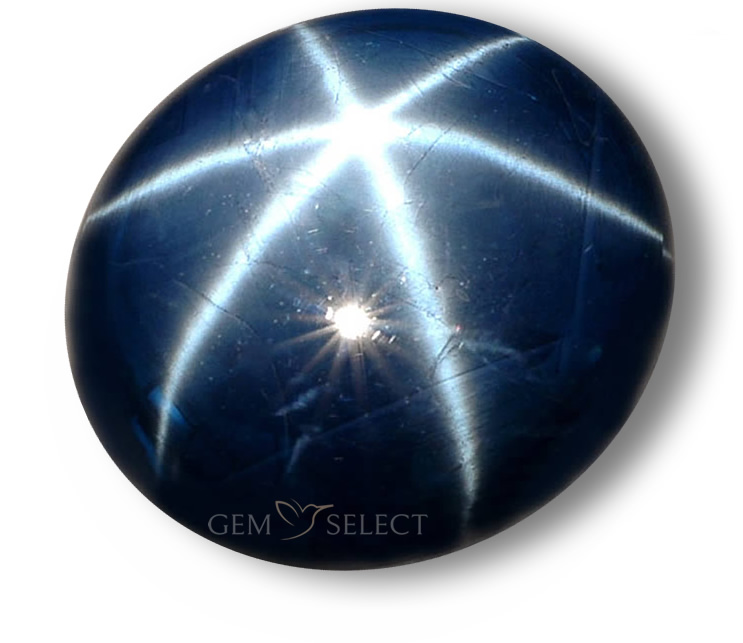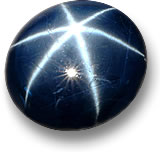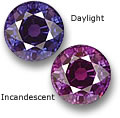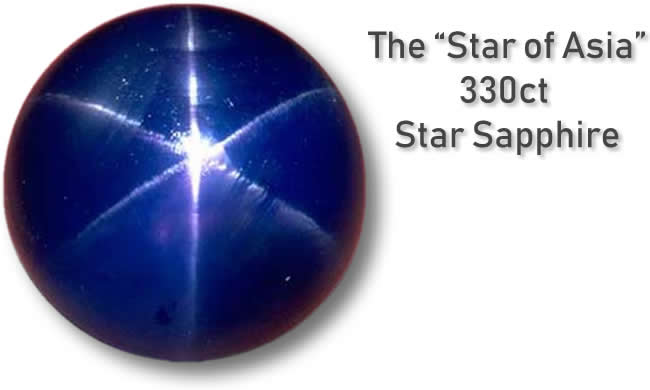Star Sapphire Gemstone Information

Buy Star Sapphire Gemstones from GemSelect
About Star Sapphire - History and Introduction
Star sapphire is rare variety of sapphire that exhibits a rare asterism under specific lighting. When viewing star sapphire, a six-rayed star will appear to float across the surface of the stone. The effect is best viewed under a direct light source and while tilting and rotating the stone from different angles. Star sapphires contain unusual tiny needle-like inclusions of rutile.
Aligned needles that intersect each other at varying angles produce the rare phenomenon known as asterism. The observed pattern is a result of light reflecting off mineral rutile inclusions present within the gemstone. These rutile inclusions primarily consist of titanium dioxide, which imparts a white color. Star sapphires can range in color from blue in various tones to pink, orange, yellow, green, lavender, gray or black. The most desirable color is a vivid, intense blue. Most star sapphire exhibits a white star, but star sapphire from Thailand is famed for its gold colored asterism.
Sapphire is a member of the corundum family and is closely related to ruby; the red to pink-red gem-quality variety of corundum. All corundum has a hardness rating of 9, making it the second hardest material on earth, second only to diamond. The name 'corundum' comes from the Sanskrit word 'kuruvindam', meaning 'ruby sapphire', while the term 'sapphire' is derived from the Persian word 'safir', which originates from the Greek word for 'blue'.
|
|

|
Star sapphire can be distinguished from other forms of sapphire by its unique asterism. The six-rayed-star effect appears most clearly under natural light, but it can also be viewed using a strong source of direct light such as a penlight or a halogen bulb. It has no distinct cleavage and has a hardness rating of 9 on the Mohs scale. Chemically, star sapphire is an aluminum oxide and forms as trigonal crystals. Owing to star sapphire's superior hardness and durability, it's nearly unmistakable, despite several other gem types that are known to occur with similar colors and luster. Some commonly confused gems include star garnet and star diopside.
The most important deposits of fine star sapphire today are found in Australia, Myanmar (Burma), Sri Lanka and Thailand. Other significant star sapphire sources include Brazil, Cambodia, China, Kenya, Madagascar, Malawi, Nigeria, Pakistan, Rwanda, Tanzania, United States (Montana), Vietnam and Zimbabwe.
Buying Star Sapphire and Determining Star Sapphire Value Back to Top
Star Sapphire Color
Star sapphires can range in color from blue in various tones, to pink, orange, yellow, green, lavender, gray and black. The coloring agents in blue sapphire are iron and titanium, and vanadium in violet to purple colored stones. A small amount of iron results in more yellow and greenish tones, while chromium produces fine pink to red tones. Iron and vanadium result in golden to orange tones. The most desirable color is a vivid, intense blue. Thai star sapphire is famed for its golden rayed star.
Star Sapphire Clarity and Luster
Star sapphire is typically opaque. Some finer specimens may exhibit slight translucency. Star sapphire owes its desirable asterism to perfectly aligned needle-like rutile inclusions. The rutile inclusions in star sapphire result in a vitreous to silky luster when cut and polished.
Star Sapphire Cut and Shape
Star sapphires are cut en cabochon typically with very high domes to maximize the desirable star effects. The best cabochons are somewhat transparent to translucent, with smooth domes of good symmetry. One should look for an even roundness to the shape. Many star sapphires will have uneven tops or bottoms, which in many cases is necessary for proper orientation in order to best display asterism.
Star Sapphire Treatment
The most common treatment for star sapphire is heat treatment. Generally before they are cut, stones are heated to between 1700 to 1800 degrees Celsius (3100-3300 degrees F) for several hours. Heating often improves the color and clarity of the gem. A reputable dealer will always disclose whether a stone has been subjected to heat treatment.
Diffusion treatment is sometimes used to improve the star effect in star sapphire. The sapphire is heated with titanium to create a more distinct star.
| Chemical Formula: |
Al2O3 Aluminum oxide |
| Crystal Structure: |
(Trigonal) doubly pointy, barrel-shaped, hexagonal pyramids, tabloid-shaped |
| Color: |
Blue in various tones, pink, yellow, green, lavender, gray, black |
| Hardness: |
9 on the Mohs scale |
| Refractive Index: |
1.762 to 1.778 |
| Density: |
3.95 to 4.03 |
| Cleavage: |
None |
| Transparency: |
Transparent, translucent, opaque |
| Double Refraction or Birefringence: |
-0.008 |
| Luster: |
Vitreous, silky |
| Fluorescence: |
Blue: none; colorless: orange-yellow, violet |
Please refer to our Gemstone Glossary for details of gemology-related terms.
Star Sapphire: Related or Similar Gemstones Back to Top
 |
| Color Change Sapphire |
Star sapphire belongs to the corundum family, which encompasses both traditional and fancy sapphires, as well as the rare red ruby. Sapphire is frequently promoted using distinct trade names that highlight its color, origin, or other notable characteristics. Some examples of varietal trade names include color change sapphire, Ceylon sapphire or Padparadscha sapphire. Since sapphire can occur in a variety of colors, it can be easily confused with other gemstones like garnet, spinel, topaz, tourmaline and zircon.
Star Sapphire Mythology, Metaphysical and Crystal Healing Back to TopSapphire is the birthstone for those who are born in September. On the zodiac chart, it is viewed as the stone for Taurus.
The ancients regarded star sapphires as powerful talismans for protecting travelers and seekers. They were considered to be so powerful that they would continue to protect the wearer even after being passed on to another person.
Abbes Hildegard von Bingen (1098-1179) chronicled the healing powers of gemstones in her book "Physica". According to her view, gemstones are formed through the powerful combination of water and fire; therefore they hold powers corresponding to these phenomena. She also believed that each stone had a certain, divine blessing from God. What she said about sapphire is: "Who is dull and would like to be clever, should, in a sober state, frequently lick with the tongue on a sapphire, because the gemstone's warmth and power, combined with the saliva's moisture, will expel the harmful juices that affect the intellect. Thus, the man will attain a good intellect."

The cover of 'Physica' by Abbes Hildegard von Bingen (1098-1179)
| Disclaimer: Metaphysical and Alternative Crystal Healing Powers and Properties are not to be taken as confirmed advice. Traditional, Ceremonial and Mythological Gemstone Lore is collected from various resources and does not represent the sole opinion of SETT Co., Ltd. This information is not to replace the advice of your doctor. Should you have any medical conditions, please see a licensed medical practitioner. GemSelect does not guarantee any claims or statements of healing or astrological birthstone powers and cannot be held liable under any circumstances. |
Star Sapphire Gemstone and Jewelry Design Ideas Back to TopIn ancient times, star sapphire was regarded as a powerful talisman guiding travelers and seekers of all kinds. Star sapphire is one of the most durable materials and can be worn daily in just about any gemstone jewelry application including daily-wear rings, earrings, necklaces, bracelets, pendants, pins and brooches. Star sapphire is ideal for jewelry that is exposed to direct light, such as cabochon rings.

'Star Sapphire' Jewelry Design Ideas - Star Sapphire with Tanzanite Earrings, Star Sapphire Pendant and Ring
When worn as earrings, star sapphire gems may not receive enough direct light for their six-rayed stars to show. Star sapphire is rarely available in large sizes, so most jewelry will feature small stones only. Some black star sapphires can be found in large sizes and these are perfect for oversized rings and pendants. Black and blue star sapphire gemstones are very popular for men's jewelry.
Note: Buy colored gemstones by size and not by carat weight. Colored stones vary in size-to-weight ratio. Some stones are larger and others are smaller than diamonds by weight in comparison.
The Smithsonian Institution in Washington D.C. displays a star sapphire of more than fifty carats that was found in Sri Lanka. The mega-star of its impressive gem collection is the "Star of Asia", a star sapphire of 330 carats.

The 'Star of Asia' - The World's Finest Star Sapphire Weighing 330 carats
Actress Mary Pickford loved very large rubies and star sapphires. She owned both the 60-carat Star of Bombay and the 200-carat Star of India, and often wore them both at the same time.
Star Sapphire Gemstone and Jewelry Care and Cleaning Back to Top Star sapphire is typically very durable and considered to be one of the hardest materials on earth. It is slightly softer than diamond, but it lacks cleavage which makes it quite resistant to damage. Fracture-filled star sapphire is not as durable as untreated star sapphire. It is not advisable to recut or repolish any star sapphire that has been fracture-filled. Even beryllium diffused sapphire may require care depending on how well the gem was diffused. Star sapphire can be brittle, so care should be taken if recutting and during setting. For cleaning, it is best to use warm soapy water and a soft cloth. As with most gemstones, avoid ultrasonic cleaners and steamers, especially with fracture-filled star sapphire; vibrations and heat can damage stones. Star sapphire is typically very durable and considered to be one of the hardest materials on earth. It is slightly softer than diamond, but it lacks cleavage which makes it quite resistant to damage. Fracture-filled star sapphire is not as durable as untreated star sapphire. It is not advisable to recut or repolish any star sapphire that has been fracture-filled. Even beryllium diffused sapphire may require care depending on how well the gem was diffused. Star sapphire can be brittle, so care should be taken if recutting and during setting. For cleaning, it is best to use warm soapy water and a soft cloth. As with most gemstones, avoid ultrasonic cleaners and steamers, especially with fracture-filled star sapphire; vibrations and heat can damage stones.
Always remove any jewelry or gemstones before exercising, cleaning or engaging in harsh physical activities. Do not expose star sapphire gemstones to acid and store them away from other gemstones to avoid scratches. It is best to wrap gemstones in soft cloth or place them inside a fabric-lined jewelry box.
|